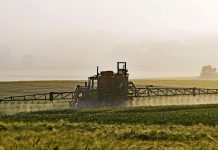WILLARD, Ohio — If you mention black muck, farmers generally know what you’re talking about.
Some may have a field or two of muck ground on their own farm, or part of a field that is muck.
But few people have the continuous acreage of muck seen June 27 on the Ohio Produce Growers and Marketers Association annual field day at Buurma Farms.
The farm is located just outside the Huron County city of Willard, in a community regarded as “”Celeryville” for the celery once grown there. Today, the Buurma family grows 30 different crops and also operates produce farms in Michigan and Georgia.
Buurma Farms is one of four major farms in the Celeryville muck region, and consists of roughly 1,500 acres.
Different soil
The first thing noticeable about the soil is its color — a dark black common to muck grounds where water once covered and layers of organic matter accumulated. The ground was drained by Buurma family ancestors more than 100 years ago and farmers in the region have been improving their “muck farming” practices ever since.
Bruce Buurma told field day visitors about the many challenges and opportunities with muck. During dry weather, like the year most of Ohio has experienced so far, the muck turns powdery and fine, about like flour. When it’s wet, it’s the opposite.
“When it’s wet, it’s slimy and gooey, and when it’s dry, it’s just like flour, and literally as dry as flour,” Bruce Buurma said.
Because the soil is so powdery when dry, erosion is a serious concern. Roughly one-half an inch of soil erodes on an annual basis, but this past spring the farm lost even more — between 2 and 2.5 inches — because of the dry weather and wind.
The farm has a lengthy history of using irrigation and currently irrigates fields 24-hours a day, six days a week. Large irrigation units are set up to operate mostly on their own, and the farm pulls water from a 75-acre above ground reservoir, built specifically for the muck farms in the region. At maximum use, two pumps can pump a combined 600,000 gallons of water per hour into the reservoir.
Agricultural diversity
Ohio Agriculture Director Dave Daniels joined the tour at the Buurma processing facility, where vegetable plants are washed, processed and boxed for retail markets. The farm is a major supplier for Kroger Co. and Meijer.
Daniels, originally from Ohio’s Highland County, said it was the largest produce farm he had visited. He was shown the whole farm, from field to harvest, and processing.
“This is agricultural diversity,” he said. “This is a food-to-the-table operation.”
The Buurma family is now in its fifth generation and has been farming at the Celeryville-Willard farm since 1896. The family works together as a corporation and there are jobs for young and older family members.
“That just goes to show the family commitment of agriculture here in Ohio,” Daniels said. “Stop and think about your heritage and look back and know what your family has been doing for the last 200 years. That’s important.”
As times change, so does the demand for different products. Bruce Buurma said a big change is the increased demand for salsa and herbs that go into it. Ten years ago, they were growing 5 acres of the herb cilantro; today, they produce 250 acres of cilantro.
Local economy
During the busiest season, the four major muck farms employ a combined 1,200 people, Bruce Buurma said. Many are seasonal workers who come from the south and stay in housing provided by the farm.
Buurma said the local business community is encouraged to see the workers return, because it creates more business at local restaurants, Laundromats and so forth.
“There’s a lot of income that’s being spent in this area from farms,” he said. “It’s like adding a small city when we’ve got all of our people here and the money they’ve spent.”
Many of the seasonal workers come as whole families and work together. If a family member cannot work outdoors, there are jobs inside the packing facility that are generally cooler and involve less walking.
But outside workers are cared for, Buurma said, because the farm values its workers and wants them healthy so they can do their best work.
Warmer soil. He said the black soil tends to be a few degrees warmer than the air, and during extreme weather events, it can heat to 105 degrees or more. When that happens, the farm takes Gatorade to its workers to keep them hydrated and keep their electrolytes up. And when the heat becomes unbearable, Buurma said they send workers home early.
Lisa Schacht, president of Ohio Produce Growers and Marketers Association, said the farm was chosen for the tour because of its growth and innovation, as well as its focus on food safety.
“This is a perfect example of long-term, large operation of food to table,” she said. “It’s truly the kind of food that people advocate that we need to have in our diets and that this scale is possible.”
Eshleman Fruit Farm uses trellises, orchard management to produce fruit
CLYDE, Ohio — Produce growers, researchers and trade groups made their way through the orchards of Eshleman Fruit Farm June 27 for the start of the annual Ohio Produce Growers and Marketers Association annual summer field day.
The event kicked off early in the morning at Eshleman’s, with tractor and wagon tours and a trade show of 25-30 different vendors.
Bill Pitts of Wafler Nursery in Wolcott, N.Y., showed growers the proper way to attach apple trees to “tall spindles,” — wire structures that encouraged the trees “to go up in the air,” toward the trellis.
He also showed visitors how to prune fruit trees and encouraged them not to be afraid to prune some branches back closer to the trunk, because removing more of the branch early on can often lead to a healthier tree and more fruit as the tree matures.
The tall spindles were one of the key highlights of the field tours, along with proper peach planting.
Rich Eshleman, who runs the farm with his wife, Betty, estimated 200-225 people came to his farm for the tour, before making their way to Buurma Farms near Willard in the afternoon.
Food safety
Karl Kolb, who is helping coordinate a statewide food safety certification plan called the Ohio Produce Marketing Agreement — gave an update about food safety and the importance of having a program in place at each produce farm.
He said farmers need a food safety plan to ensure they’re producing safe food, and to protect their liability interests if a complaint is ever filed.
“(Having a plan) is the easiest thing you can do,” he said. “Food safety is not hard.”
Eshleman Fruit Farm has been a family owned operation since 1977. Today, it generally consists of 150 acres of apples, six acres of sweet cherries, three acres of plums, six acres of apricots and 50 acres of peaches.
New plantings are high density, dwarf trees that grow better quality fruit. The main orchard has trickle irrigation and many new varieties.
The farm has a 20,000-bushel cold storage and a 25,000-bushel controlled atmosphere storage facility. The Eshlemans produce about 18,000 bushel of peaches and 40,000 bushel of apples each year.
The farm also offers pick-your-own fruit.
Lisa Schacht, president of OPGMA, said the summer field day is a way to “complement the OPGMA Congress that we have annually (in Sandusky) with on-farm, visible activity and production in focus.”
Read Chris Kick’s blog post about his experience traveling across the state.









